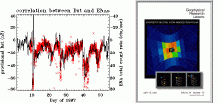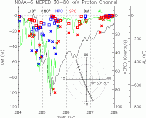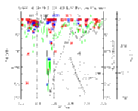
Tomographic ENA Imaging from Low-Earth Orbit
1R. B. Sheldon, 2T. A. Fritz, and 2H. E. Spence
1The University of Alabama in HuntsvilleHuntsville, AL 35899
2Boston University Center for Space Physics
725 Commonwealth Av, Boston, MA 02215
October 1998

 Schematic of Global Energetic Neutral Atom Imaging
Schematic of Global Energetic Neutral Atom Imaging
 Correlation Between ENAs and Dst and Global Storm Imaging
Correlation Between ENAs and Dst and Global Storm Imaging

 Correlation Between ENAs and Dst/AL From TIROS
Correlation Between ENAs and Dst/AL From TIROS
 Global ENA Images from POLAR During a Moderate Magnetic Storm
Global ENA Images from POLAR During a Moderate Magnetic Storm
|
Table 2: TENACIUS ENA Imager Compared with Complementary Imagers |
||||
|
MISSION |
TENACIUS |
IMAGE |
TWINS |
POLAR |
|
Mission Type |
UNEX |
MIDEX |
MOO |
ISTP |
|
Mission Cost (excluding launch) |
<6 M$ |
~45M$ |
~15M$ |
>150M$ |
|
ENA Instrument |
IEPS |
HENA |
MENA |
IPS |
|
Global Imaging |
regional |
yes |
yes |
yes |
|
Energy Range (keV) |
15-400 |
10-200 |
1 – 100 |
15-1500 |
|
Energy Resolution (DE/E) |
0.15 |
0.7 |
0.4 |
0.15 |
|
Number of Energy Bins |
8 |
4 |
16 |
|
|
Angular Resolution (degrees) |
12 ´ 20 |
4 ´ 6 |
4 ´ 4 |
12 ´ 20 |
|
Typ. Projected Spatial Res. (RE) |
0.03 ´ 0.05 |
0.5 ´ 0.75 |
0.5 ´ 0.5 |
1.9 ´ 3.2 |
|
Typ. Temporal Res (seconds) |
10 |
300 |
60 |
96 |
|
Typ. pixel dimension (mm) |
2.0 ´ 3.5 |
1.5 ´ 1.5 |
1.5 ´ 3.0 |
|
|
Geom. Fact./pixel (cm2-sr) |
5´10 -3 |
1.4´10-3 |
3´10 -3 |
|